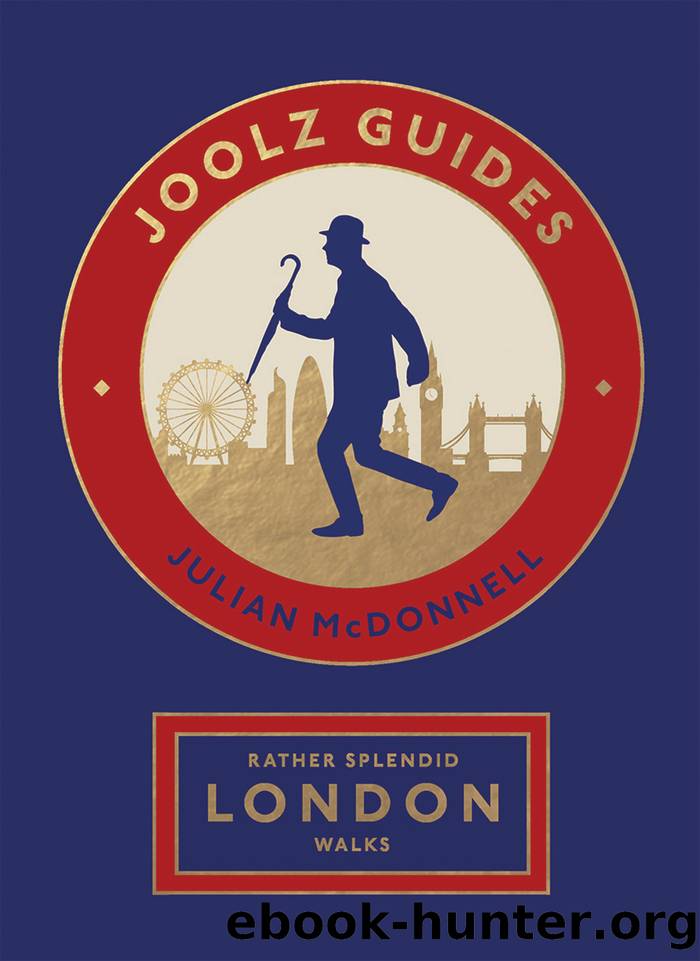Rather Splendid London Walks: Joolz Guides' Quirky and Informative Walks Through the World's Greatest Capital City by Julian McDonnell

Author:Julian McDonnell [Julian McDonnell]
Language: eng
Format: epub
Publisher: Quadrille
Published: 2023-02-07T00:00:00+00:00
By the way, opposite the house is a river that is usually covered in green algae. This is the continuation of the New River, which we saw earlier in the walk and used to stretch down to Islington. This section has been retained as a sort of long pond, but doesnât really flow any more.
Just before exiting the park, past Clissold House towards Stoke Newington Church Street, take a look at the rather excellent boundary stone with â1790â on it. I guess the â1790â refers to the year the big house was built. This stone lies on the boundary of the old parishes of Stoke Newington and South Hornsey, which I know because there are some slightly later Victorian metal ones hidden just behind the railing on your right, near the bus stop as you turn out of the park into Stoke Newington Church Street.
Facing you as you leave the park is a beautiful terrace of houses on Spensley Walk called PARK CRESCENT , which must be one of the most desirable addresses in the area. Back in the 1980s these were all Housing Association accommodation, but through the âRight to Buyâ scheme some of the people living here snapped up the opportunity to buy their flats for a good price and have remained there ever since. Itâs a tremendous location.
On Stoke Newington Church Street turn left and youâll see (new) ST MARYâS CHURCH . There are actually two churches here, the old one being opposite, on the left side of the road, but itâs obscured by the trees. The new church replaced the old one in 1854 and was designed by George Gilbert Scott, who also did the Albert Memorial and St Pancras Station. They were quite a family of architects â it was originally built without a steeple, so later his son came along and put a spire on it, before his grandson, Giles Gilbert Scott, designed the red telephone box and the Pink Floyd album cover (well, Battersea Power Station, actually, not the album coverâ¦) and the Tate Modern.
Cross the road and head into the churchyard of (old) ST MARYâS CHURCH , if youâre not scared of having nightmares. Itâs quite unusual to have two St Maryâs churches right opposite each other, but this one was the old parish church and is now used as an arts venue. Itâs the oldest church in the country that was actually built as an Anglican church, and the only Elizabethan church left in London. Personally, I find all the graves really spooky, especially the ones which are half open. It looks like someone has tried to crawl out of them during the night! One of the graves here is that of James Stephen, a lawyer who drafted the Slave Trade Act in 1807. Along with his brother-in-law William Wilberforce and his friends Samuel and Jonathan Hoare, he set up the Society for Effecting the Abolition of the Slave Trade.
London is full of buildings and street furniture with initials and coats of arms all over the place, and I find it fun to discover what they actually mean.
Download
This site does not store any files on its server. We only index and link to content provided by other sites. Please contact the content providers to delete copyright contents if any and email us, we'll remove relevant links or contents immediately.
| Great Britain | General |
| Bath | Devon |
| Gloucestershire | London |
| Yorkshire |
Spell It Out by David Crystal(35349)
Underground: A Human History of the Worlds Beneath Our Feet by Will Hunt(11263)
A Year in the Merde by Stephen Clarke(4659)
Venice by Jan Morris(2052)
Claridge's: The Cookbook by Nail Martyn & Erickson Meredith(1964)
My Paris Kitchen: Recipes and Stories by Lebovitz David(1894)
A TIME OF GIFTS by Patrick Leigh Fermor(1850)
The Plantagenets by Dan Jones(1617)
Welcome to the Goddamn Ice Cube by Blair Braverman(1603)
Bang Poland: How To Make Love With Polish Girls In Poland by Roosh V(1590)
Top 10 Prague (EYEWITNESS TOP 10 TRAVEL GUIDES) by DK(1569)
From Russia with Lunch by David Smiedt(1552)
The Finnish Way by Katja Pantzar(1537)
The Isle of Mull by Terry Marsh(1521)
A TIME TO KEEP SILENCE by Patrick Leigh Fermor(1500)
Rick Steves London 2018 by Rick Steves & Gene Openshaw(1494)
A Taste of Paris by David Downie(1492)
Merde in Europe by Stephen Clarke(1436)
Insight Guides Experience Tokyo by Insight Guides(1419)
